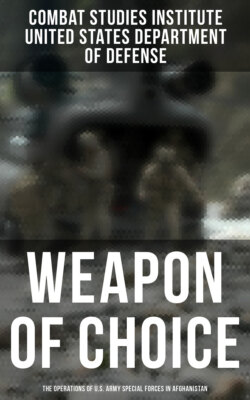Читать книгу Weapon of Choice: The Operations of U.S. Army Special Forces in Afghanistan - Combat Studies Institute - Страница 27
На сайте Литреса книга снята с продажи.
Special Forces: CSAR Personnel Recovery and UW Preparation
ОглавлениеMAJ Steven Broderick (pseudonym), commander, B Company, 3rd Battalion, 5th SFG, arrived during the night of 7 October with ODB 580. Master Sergeant (MSG) Bowdler (pseudonym) from the 5th SFG advance party met the 18 Special Forces soldiers, got them through customs, and got the group bunked down for the night in a few medium-size general purpose tents. Their main tasks were to establish an isolation facility (ISOFAC) for the ODAs preparing for future combat missions and to provide force protection at K2 and in the local area. Restrictions imposed by the Uzbeks made any force protection measures outside K2 Air Base impossible. The Special Forces soldiers spent several days erecting 18 tents; setting up cots, tables, and chairs; and installing fuel oil heaters to create an ISOFAC. Long working hours became the norm as more and more ODAs kept arriving at K2. Although Broderick’s ODB had never set up or operated an ISOFAC, the NCOs applied their experience and SOPs to provide a working operation in record time. SFC Kevin Anderson (pseudonym) coordinated the use of local marksmanship ranges with the Uzbek military to assist the ODAs in isolation. COL Kisner’s JSOTF staff was concentrated on the CSAR mission of the air campaign. Getting the ISOFAC ready to accommodate the additional ODAs involved in the UW campaign was a subsequent Army Special Forces mission, and MAJ Broderick’s ODB 580 was expected to “carry that ball” alone.
Broderick and his ODB 580 isolated the first 11 Special Forces teams (ODAs) going into Afghanistan. Missions and insertion times differed between ODAs, and there were constant adjustments based on contact with Northern Alliance combat leaders, weather, and intelligence factors. MAJ Broderick and his operations sergeant, Sergeant Major (SGM) Manuel Victoro (pseudonym), kept the teams attuned to the constant mission changes by attending briefings in the JSOTF and JSOAC. They restricted access to the ISOFAC to reduce rumors and divert uncoordinated conflicting information from the teams. Broderick discovered COL Mulholland’s key concerns during the JSOTF commander’s premission back briefs for each ODA. Sharing these insights with the ODA commanders reduced mission assignment turbulence that accompanied unsatisfactory premission briefs to the commander and focused planning better.
